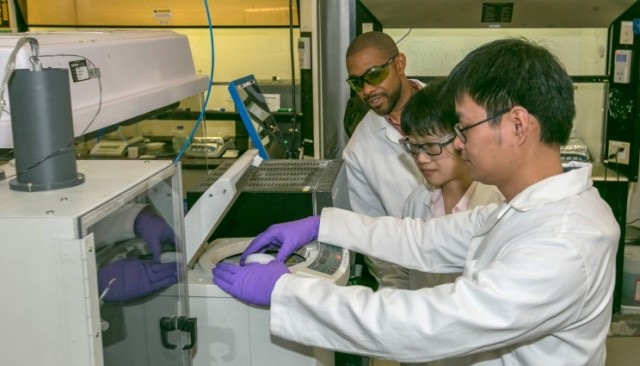Jun 20 2016
Scientists at the Lawrence Livermore National Laboratory (LLNL) and UC Santa Cruz (UCSC) have developed a new technique to increase the performance of 3D-printed graphene-based supercapacitors by two-fold.
 Lawrence Livermore National Laboratory engineer Cheng Zhu mixes ink material while scientists Fang Qian and Marcus Worsley observe.( Credit-Photo by Julie Russell/LLN)
Lawrence Livermore National Laboratory engineer Cheng Zhu mixes ink material while scientists Fang Qian and Marcus Worsley observe.( Credit-Photo by Julie Russell/LLN)
In this technique, perchlorate ion and lithium ion are packed between graphene layers in aerogel electrodes that considerably enhanced the capacity of the electrodes and at the same time maintained the excellent rate capability of the devices. The research findings were reported online, and are also featured as the back cover in the June edition of ChemNanoMat journal.
This is a unique method that significantly raises the performance of our previous graphene aerogel supercapacitors. We’ve modified the devices and found the best recipe.
Cheng Zhu, Engineer, LLNL
For the experiment, the UCSC team received the 3D-printed graphene aerogel electrodes from LLNL researchers. These electrodes were developed using a direct ink writing procedure. The exceptional conductivity and the ultra-large surface area of the graphene-based materials make them suitable for use in supercapacitors.
This technique takes place in two ion-intercalation steps - perchlorate-ion intercalation and lithium-ion intercalation and this is followed by hydrolysis of perchlorate ion intercalation compounds.
“This two-step electrochemical process increases the surface area of graphene-based materials for charge storage, as well as the number of pseudo-capacitive sites that contribute additional storage capacity,” said LLNL material scientist and paper co-author Fang Qian.
According to UCSC professor and corresponding author Yat Li, the capacitance of graphene aerogel is restricted by its comparatively small ion-accessible surface area. This happens due to stacking and aggregation of graphene sheets.
This study presents a facile method to boost the capacitive performance of 3-D-printed graphene aerogel by exfoliating the stacked graphene layers and functionalizing their surface, without damaging structural integrity.
Yat Li, Professor, UCSC
According to Zhu, these findings are the next steps to make more complicated architectures utilizing aerogels. This will pave the way for more powerful supercapacitors that could be integrated in custom-made electronics in the future.
“In the future, I think every device will be customized, so you need the unique architecture or shape (for the supercapacitor),” Zhu said. “If you can 3-D print it, you can make any shape you want. In the future, everyone could design their own iPhone.”
The research program was funded by the Laboratory Directed Research and Development (LDRD).